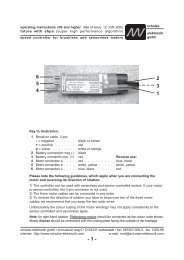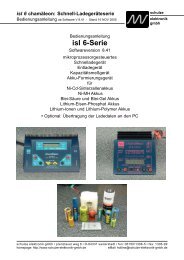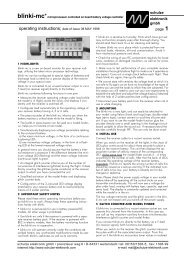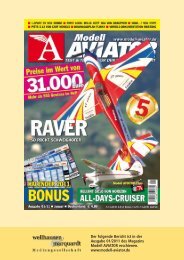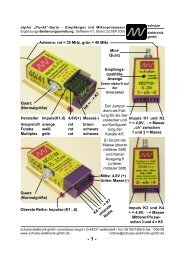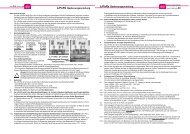isl 6 chameleon: rapid charger series - Schulze Elektronik GmbH
isl 6 chameleon: rapid charger series - Schulze Elektronik GmbH
isl 6 chameleon: rapid charger series - Schulze Elektronik GmbH
Create successful ePaper yourself
Turn your PDF publications into a flip-book with our unique Google optimized e-Paper software.
page 2<br />
1 Warnings<br />
Injury hazard! Beware of sharp-edged parts<br />
(heat-sink, terminal clips) when handling the<br />
<strong>charger</strong>.<br />
The CE symbol does not entitle you to be careless<br />
when using or handling the <strong>charger</strong>, the<br />
power supply and the batteries.<br />
Before you connect the <strong>charger</strong> to a 12 V car<br />
battery ensure that the vehicle's engine is<br />
stopped. The <strong>charger</strong> may only be operated<br />
with the vehicle stationary and the engine<br />
stopped.<br />
The <strong>charger</strong> must be used with the original cables<br />
in unmodified form. The only permissible<br />
change is to use 4 mm gold-contact connectors.<br />
Never use wander plugs!<br />
Avoid short-circuiting the charge outputs to the<br />
car bodywork, as the <strong>isl</strong> 6 is not protected<br />
against this. In the interests of safety always<br />
place the <strong>charger</strong> on the ground.<br />
The charge leads and/or charge outputs must<br />
not be inter-connected or short-circuited in<br />
any way, as the result would be damage to<br />
the <strong>charger</strong> and/or the battery. To avoid<br />
shorts between the banana plugs on the<br />
charge lead please be sure to connect the<br />
charge cable to the <strong>charger</strong> first, and only<br />
then to the battery to be charged. Reverse<br />
the sequence when disconnecting. We recommend<br />
our safety charge lead which features<br />
no exposed banana plug contacts, as<br />
they are protected by a spring-loaded insulating<br />
sleeve.<br />
To meet the CE standards the length of the<br />
charge leads must not exceed 20 cm.<br />
There is always a danger of explosion when<br />
handling <strong>rapid</strong>-charge Ni-Cd batteries. To<br />
avoid problems never leave the <strong>charger</strong> unsupervised<br />
whilst <strong>rapid</strong>-charging is in<br />
progress.<br />
Before using the <strong>charger</strong> place the unit and the<br />
batteries to be charged on a non-flammable,<br />
heat-resistant and electrically non-conductive<br />
surface.<br />
Keep inflammable objects and volatile materials<br />
well away from the charging station.<br />
<strong>isl</strong> 6 <strong>chameleon</strong>: <strong>rapid</strong> <strong>charger</strong> <strong>series</strong><br />
When you wish to charge batteries, remove<br />
them from the model or electrical device.<br />
When charging transmitter batteries it is essential<br />
to keep within the maximum charge current<br />
permitted for the transmitter circuit<br />
board by setting the charge current manually<br />
(0.5 - 2 A, see manufacturer's specification).<br />
If you set the <strong>charger</strong>'s automatic charge termination<br />
to "sensitive+delayed", note that topping-up<br />
full cells makes them very hot.<br />
Never connect the <strong>isl</strong> 6 to a car battery which is<br />
simultaneously being charged by a car battery<br />
<strong>charger</strong>.<br />
Protect the <strong>isl</strong> 6 from damp, water, shock and<br />
pressure.<br />
The unit must not be used if it exhibits any fault<br />
or is displaying an error message.<br />
Charging fewer than 4 cells at output 1: the<br />
special 16-bit A/D converter is outstanding<br />
accurate, but we cannot guarantee that the<br />
<strong>charger</strong> will work correctly in this situation.<br />
The charge termination may occur too early,<br />
too late, not at all, or even perfectly correctly,<br />
and the charge current will not approach<br />
the maximum rate. The reason for this is<br />
that the "kink" in the voltage curve of highcapacity<br />
cells is very slight.<br />
The following types of battery / pack / cell must<br />
not be connected to the <strong>charger</strong>:<br />
- packs consisting of different types of cell<br />
- mixtures of old and new cells, or cells of<br />
different make<br />
- non-rechargeable batteries (dry cells)<br />
- batteries which are not expressly stated by<br />
the manufacturer to be suitable for the high<br />
charge currents which this <strong>charger</strong> can supply.<br />
- individual faulty or damaged cells<br />
- batteries which are already fully charged or<br />
hot<br />
- batteries fitted with integral charge devices<br />
or charge termination circuits<br />
- batteries which are installed in a device, or<br />
are also connected electrically to other components.<br />
schulze elektronik gmbh prenzlauer weg 6 D-64331 weiterstadt tel: 06150/1306-5, fax: 1306-99<br />
internet: http://www.schulze-elektronik.com e-mail: mail@schulze-elektronik.com



